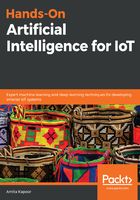
Learning paradigms
ML algorithms can be classified based on the method they use as follows:
- Probabilistic versus non-probabilistic
- Modeling versus optimization
- Supervised versus unsupervised
In this book, we classify our ML algorithms as supervised versus unsupervised. The distinction between these two depends on how the model learns and the type of data that's provided to the model to learn:
- Supervised learning: Let's say I give you a series and ask you to predict the next element:
You guessed right: the next number will be 36, followed by 49 and so on. This is supervised learning, also called learning by example; you weren't told that the series represents the square of positive integers—you were able to guess it from the five examples provided.
In a similar manner, in supervised learning, the machine learns from example. It's provided with a training data consisting of a set of pairs (X, Y) where X is the input (it can be a single number or an input value with a large number of features) and Y is the expected output for the given input. Once trained on the example data, the model should be able to reach an accurate conclusion when presented with a new data.
The supervised learning is used to predict, given set of inputs, either a real-valued output (regression) or a discrete label (classification). We'll explore both regression and classification algorithms in the coming sections.
- Unsupervised learning: Let's say you're given with eight circular blocks of different radii and colors, and you are asked to arrange or group them in an order. What will you do?
Some may arrange them in increasing or decreasing order of radii, some may group them according to color. There are so many ways, and for each one of us, it will be dependent on what internal representation of the data we had while grouping. This is unsupervised learning, and a majority of human learning lies in this category.
In unsupervised learning, the model is just given the data (X) but isn't told anything about it; the model learns by itself the underlying patterns and relationships in the data. Unsupervised learning is normally used for clustering and dimensionality reduction.